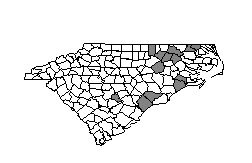![]()
<< Back :: Virginia :: North Carolina :: South Carolina :: Georgia :: FWGNA Home ::
![]()
<< Back :: Virginia :: North Carolina :: South Carolina :: Georgia :: FWGNA Home ::
>Lioplax subcarinata (Say 1817)
> Habitat
& Distribution
Burch (citing Clench & Turner 1955, Clench 1965, and Vail 1979)
gave the
range of L. subcarinata as the Hudson River drainage south to
South
Carolina. But Jokinen (1992) reported
the species extirpated from New York, and for years I was unable to
confirm the
occurrence of Lioplax at the southern limit of its range
as
well. The essay I posted in 2004
reporting the rediscovery of the species in the Lynches River near
Bishopville
is reachable from the link below. The
animals seemed fairly common in the summer of 2004, burrowing in
extremely
flocculent silt. I have subsequently collected Lioplax downstream as far as
Lynches Mill in Florence County.
In 2005 my attention was called to a second South Carolina population, this in the Waccamaw River at Peachtree Landing, Horry County (Tim Savidge). And the species is not uncommon in North Carolina. It would appear that the rarity of Lioplax in South Carolina may simply be a consequence of the species reaching the southern edge of its natural range.
> Ecology
& Life History
The ecological literature contains few studies specifically addressing Lioplax. But judging from its biological similarity
to Campeloma, one might infer that Lioplax has the
ability to
filter feed or suspension feed on fine organic particles. Unlike Campeloma, however, there is
no evidence of parthenogenesis in Lioplax, as far as I am aware
(Vail 1977). Vail (1978) reported a
perennial, iteroparous life cycle for the population of Lioplax
pilsbryi
she studied in north Florida (Hi of
Dillon 2000), animals requiring two years to mature.
> Essay
I published an essay reporting the rediscovery of Lioplax in
South
Carolina on 26Aug04. Photos of the
habitat and the living animal are available from that page.
> Taxonomy
&
Systematics
Six nominal species of Lioplax are listed in Burch, but only L.
subcarinata occurs in Atlantic drainages. The genus attracted considerable attention in the mid -20th
century, first from Clench (e.g. Clench & Turner 1955, Clench 1962)
then
from V. A. Vail, and has subsequently enjoyed a period of taxonomic
stability. Vail (1977) has published a
nice set of anatomical observations on Lioplax pilsbryi from
north
Florida.
>Maps of Lioplax distribution
Click the small map to enlarge
it, or download the state-specific PDFs

North Carolina (PDF)
South Carolina (PDF)
Robert T. Dillon, Jr.
Department of Biology, College of
Charleston
Charleston, SC 29424
P: 843.953.8087
F: 843.953.5453